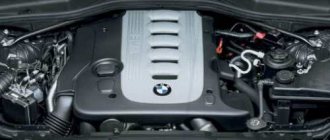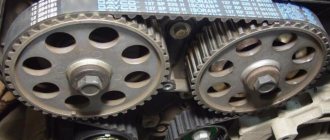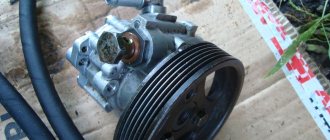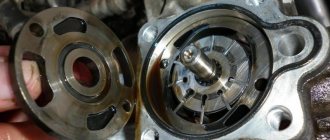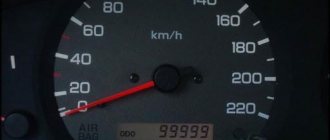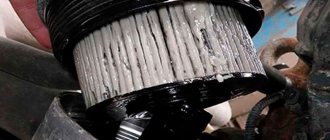Many drivers are familiar with the situation: when driving in a straight line, the car goes quietly, but when you turn, “singing” begins. There are many options for answering where the noise is coming from, so before making repairs you need to make sure that the source is identified correctly. Correct diagnostics will eliminate the need to spend money on replacing a unit that could still serve. Let's try to figure out which bearing is humming when turning, and what could be making noise besides it.
Use Suprotek lubricant
Feedback about use:
Valentin, Yeysk
Hyundai Santa Fe
I have been using Suprotek restoration lubricant for several years, maintaining the front ball joints. At the moment, everything in the car is original. All reviews >>
Extraneous sound in power steering (main reasons)
There are several reasons why extraneous sounds occur in the hydraulic booster.
Here are some of them:
- Low hydraulic fluid level. Be sure to check the fluid level in the power steering; if the indicator is at the minimum level, you should add oil.
- The liquid does not correspond to the temperature conditions. If a sharp change in temperature is expected in the region, for example the onset of frost, it is worth replacing the liquid with one more suitable for winter.
- Poor quality oil. If there is a smell of burnt rubber in the cabin, you should check the hydraulic fluid for contamination. If, when checking the oil, the color of the liquid does not match the color when filling, this indicates that it urgently needs to be replaced. It is best to change the power steering fluid exactly according to the schedule established when the car was released.
- Airing the power steering system. Air entering a closed system is very dangerous. If foam forms on the surface when opening the reservoir, you should urgently bleed the power steering or replace the fluid.
- Damage to the steering rack. The main sign of a malfunction is a knocking sound from the front wheels or in the steering rack housing. The causes of damage can be different, most often it is wear of the gasket, malfunction of the tie rod boots. If there is the slightest problem with the steering rack, repairs are necessary.
- The power steering drive belt is loose or completely worn out. The lower the belt tension when the engine is running, the more it heats up. In such cases, the drive belt needs to be completely replaced, or the belt should be tensioned according to the manual.
Damage to the power steering pump part. The most complex and expensive breakdown in the power steering system. The causes of failure can be different, for example, faults in pump parts, such as bearings or seals.
Constant-velocity joint
With the wheels turned completely to one side, the CV joint will most often creak (it may even give impacts to the steering wheel). When turning the car to the left, the right outer CV joint will crunch/knock, and when turning to the right, the left one will, accordingly. Inner CV joints usually creak when driving at high speed on uneven roads, so they have nothing to do with knocking when turning. So if you hear a knocking sound when turning or sharply accelerating your car, the outer joint most likely needs to be replaced. However, first you can remove it and inspect it - if there is no wear or it is small, then CV joint lubrication will help.
The hydraulic booster whistles, hums, vibrates when cold
- The main reason for a hydraulic unit whistling when cold is low-quality or recycled oil. This may be indicated by a strong hum when the power steering operates in winter. Old, recycled oil thickens at low temperatures and makes it harder for the system to pump.
- Air entering the pressure lines. Air leaks can cause severe damage to the entire power steering system, because unaccounted for oxygen changes the properties of the hydraulic fluid, causing the engine itself and all its parts to suffer.
- Poor flushing of the entire hydraulic system. After improper flushing of the system, an air bubble forms at the bottom of the liquid tank, which interferes with the normal operation of the hydraulic booster, resulting in extraneous noise.
- Hydraulic fluid contamination. Even the smallest specks of dust and remaining dirt in the tank can lead to damage not only to the hydraulic unit itself, but also to the steering rack and engine. Check carefully for dirt when changing oil.
- Hydraulic power steering bearing failure. With such a breakdown, the extraneous sound will be constant.
- Chemical elements and salts. In winter, roads are covered with special anti-ice compounds, which in turn corrode oil seals and anthers, which leads to hydraulic failure and the appearance of extraneous sounds during operation.
Subframe (atypical situations)
Sometimes atypical situations that are quite difficult to diagnose lead to knocking when turning. For example, there is a known case when, while the car was moving, a small stone hit the subframe and got stuck there. When you turn the steering wheel in one direction or the other, a natural displacement of the steering gear elements occurs, and they seem to run over this stone. When the elements were restored to their original position, they jumped off the stone, making a characteristic sound. The problem was solved by removing the stone.
Extraneous sound when turning sharply
During sharp turns, when the wheels are turned all the way, the load on the hydraulic booster increases many times. As a result, extraneous sound may appear. Which is not necessarily the cause of the breakdown.
- For such subtle differences, you need to thoroughly study the manual when buying a car.
- Manufacturers describe all possible options there, including this one.
- Another reason for the sound when turning the wheels is the blocking of the fluid flow by the bypass valve.
At the same time, the pump begins to heat up. Which can cause serious damage. Do not keep the wheels turned to maximum for more than 5 seconds.
Grinding, as well as squeaking (the steering wheel turns both when driving and when standing still)
A grinding/creaking sound that is felt when the steering wheel is turned in different directions. This noise occurs due to wear on the suspension joints or steering joints. Similar to the previous point, here you will need to diagnose the suspension components or steering system, replacing worn parts, if necessary.
However, the most common reason for such a sound is the lack of lubrication in the steering tips (as well as their severe wear).
Thanks for subscribing!
Sometimes such a squeak can even be accompanied by a crunching sound, regardless of whether the car is moving or standing still. In this case, the culprits are the lower ball joints (sometimes the shock strut bearings). The first option is also accompanied by play in the steering wheel when the car is suspended.
Hydraulic noise after fluid change
After replacement, an extraneous sound occurs in the pump part due to the change of power steering fluid. Friction increases between the inside of the stator ring and the rotor plates. Vibration of the plates appears.
To avoid this, you should select hydraulic fluid according to the recommendations in the manual.
conclusions
Any vehicle is a complex system consisting of thousands of different components. Therefore, various kinds of noise can appear both due to serious problems in the mechanisms, and due to the weakening of any simple element in the interior.
However, the car owner must carefully monitor the appearance of various kinds of sound effects both while the car is moving and when turning the steering wheel while parked. After all, only timely diagnosis of a problem can be considered the key to successful repair and safe driving.
It should be borne in mind that any difficulties that arise with turning the steering wheel must be resolved immediately, since the problem may result in the failure of one of the elements of the control system and an accident. You should not ignore the appearance of sounds uncharacteristic of vehicle operation, since the safety and even lives of people depend on it.
Tips for good power steering performance
By following simple rules, it is very easy to increase the service life of the hydraulic steering system.
- Timely check of the hydraulic fluid level;
- Oil change exactly on schedule;
- Fix the wheels in a level position;
- If there is a problem with the hydraulic system, correct the problem immediately;
- Periodically inspect the steering rack for damage and malfunctions;
- Choose high-quality power steering fluid.
Do not make sharp turns with the wheels turned out, or fix this position for no more than 5 seconds.
By strictly following all the rules for the safe operation of a hydraulic installation, you can maintain its functionality for a long time and save a lot on expensive repairs.
Rules for proper use
If you do not want to face the problem of hum, then the first thing you need to do is to use your car correctly. First of all, keep in mind that on vehicles with power steering, you should not hold the steering wheel in one position for too long when turning or performing a maneuver. This is because during operation of the machine, the power steering device begins to heat up, the same applies to the working fluid, and if you keep the unit in one state, the liquid may even boil. Accordingly, the problem cannot be solved except by replacing the lubricant.
Experts also do not advise leaving your vehicle with its wheels turned for a long time, particularly during the winter cold. This can also lead to undesirable consequences for the steering system. If you notice that any malfunctions have begun to appear, it is advisable to diagnose the car as quickly as possible and fix the problem.
If there are serious faults, it is better not to even try to repair the unit yourself, especially if you are not confident in yourself. The best option would be to have your car repaired at a service station. Only by identifying malfunctions in the system in time can you ensure its long-term operation.




